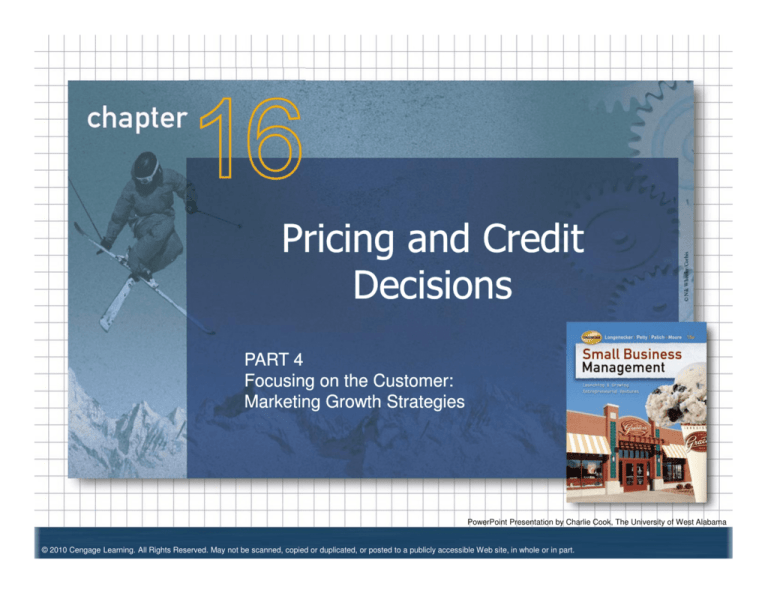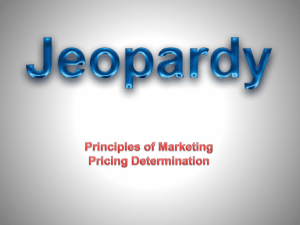
Pricing and Credit
Decisions
PART 4
Focusing on the Customer:
Marketing Growth Strategies
PowerPoint Presentation by Charlie Cook, The University of West Alabama
© 2010 Cengage Learning. All Rights Reserved. May not be scanned, copied or duplicated, or posted to a publicly accessible Web site, in whole or in part.
Exhibit 16.1 Total Cost in Determining Price
Total Sales Revenue = Reflection of sales volume and price
Make a little on a lot OR Make a lot on a little
16–5
How Customer Demand Affects Pricing
The Elasticity of Demand
The degree to which a change in price
affects the quantity demanded.
Elastic Demand
Price
Demand that changes
significantly when there
is a change in the price
of the product. EXAMPLE?
Inelastic Demand
Demand that does not change
significantly when there is a
change in the price of the product.
EXAMPLE?
Inelastic
Elastic
Demand
16–9
Elasticity - Determine Price
Check out my website:
http:instruction2.mtsac.edu/rjagodka
Click on “Entrepreneurship Resources”
Scroll down to “Tools & Databases”
Click on “Pricing”
(FREE Excel template for you to download)
Determine which price will allow you to:
- Maximize Revenue
- Maximize Margins (profits)
- Pricing on Amazon.com
16–10
Profit Contribution vs. Mark Up
Example:
Cost =
$50.00
Profit Requirement (PR) =
25%
What is the sales price, if I want 25% profit?
Profit Contribution
Mark Up
Cost / (1- PR) = Sales Price
50 / (1-.25)
50 / .75 = $66.66
Cost x (1 + PR) = Sales Price
50 x (1 + .25)
50 x 1.25 = $62.50
Sales Price – Cost = Profit
66.66 – 50 = $16.66
Sales Price – Cost = Profit
62.50 – 50 = $12.50
Profit / Sales Price = Profit Contribution Profit / Sales Price = Profit Contribution
16.66 / 66.66 = 24.9 %
12.50 / 62.5 = 20 %
16–11
Determining Volume Discounts
Given: Cost = $50.00 Profit Requirement (PR)= 25 %
Sales Price = $66.66 Profit/unit = $16.66
Sale of 20 units:
20 units @ 66.66 = $1333.20 revenue
@ 25 % PR 16.66 x 20 = $333.20 profit
5 % Discount
off the Sales Price: 66.66 – 5% = $ 63.33 profit per unit = $13.33
13.33 / 63.33 = 21 % PR
To earn same profit (25% PR) after the discount . . .
How many units to sell?
Profit (@ 25% PR) / Discounted profit per unit
333.20 / 13.33 = 25 units (need to sell 25% more units)
16–12
Profit Requirement (PR) Discount Chart
5% Price Discount
Profit Requirement (PR)
Profit After Discount
Additional Volume needed to
achieve same PR
30 %
26.30 %
20.00 %
32 %
28.40 %
18.50 %
34 %
30.50 %
17.30 %
36 %
32.60 %
16.10 %
38 %
34.70 %
15.10 %
40 %
36.80 %
14.30 %
30 %
22.20 %
50.00 %
32 %
24.40 %
45.50 %
34 %
26.70 %
41.70 %
36 %
28.90 %
38.40 %
38 %
31.10 %
35.70 %
40 %
33.30 %
33.30 %
10 % Price Discount
16–13
Pricing and Competitive Advantage
Pricing and Competitive Advantage
Customers will demand and pay more for a product or
service that they perceive as important to their needs.
Prestige Pricing
Setting a high price to convey an image of high
quality or uniqueness (competitive advantage).
Customers associate price with quality.
Markets with low levels of product knowledge are
candidates for prestige pricing. EXAMPLE?
16–14
Selecting a Pricing Strategy
Penetration Pricing
Setting lower than normal prices to hasten market
acceptance of a product or service or to increase
market share EXAMPLE?
Skimming Pricing
Setting very high prices for a limited period before
reducing them to more competitive levels EXAMPLE?
Follow-the-Leader Pricing
Using a particular competitor as a model in setting
prices EXAMPLE?
Typically set price as a percentage markdown (or up)
based on leader price
16–15
Dynamic Pricing Strategy
Charging more than the standard price when the
customer’s profile suggests that the higher price will be
accepted EXAMPLE?
Coke
machine in Japan
changes prices based
on outside temperature
–If cold – warm drink higher priced
–If hot – cold drink higher priced
Coke
machines in Japan,
Austria, etc take payment
via mobile phone and
include video
16–16
Selecting a Pricing Strategy (cont’d.)
Variable Pricing
Setting more than one price for a good or service in
order to offer price concessions to certain customers
EXAMPLE of Variable Pricing
Price Lining
Setting a range of several distinct merchandise levels
EXAMPLE?
16–17
Selecting a Pricing Strategy
Free Pricing
Ever notice that you
can get a printer for
FREE
They get you on the
ink
HP info as of March
2007
16–18
Types of Credit
Consumer Credit
Financing granted by retailers to individuals who
purchase for personal or family use.
Trade Credit
Financing provided by a supplier of inventory to a
given company which sets up an account payable for
the amount.
Terms of sale may be 1/15, net 30—one percent
discount on the invoiced amount if paid in full
within 15 days of the invoice date, otherwise the
full amount of the invoice is due in 30 days.
16–29
Should we Take the “Net 30 1/15” Discount?
Timetable
(days after invoice)
Settlement Costs for $20,000 Purchase
Day 1 through 15
$19,800
Day 16 through 30
$20,000
Day 31 and thereafter
$20,000 + possible late penalty + deterioration
in credit standing
Annualized
interest rate =
Days in year
Net period - Cash discount period
=
Annualized
interest rate
x
Cash discount %
100 - Cash discount%
365
1
X
30 - 15 100 - 1
= 24.33 x 0.010101 = 0.246, or 24.6%
Take the Discount if cash flow will allow
16–30
Marketing Strategies
What is Strategy? Harvard’s Michael Porter - film
Now we will develop our Marketing Positioning Strategy
Think of a company that you manage/own or would like to
analyze:
What is the Overall Strategy?
• Low Cost – Low end price
• Differentiated – unique from competition
Identify the overall strategy for the firm
EXAMPLES? I chose a barbershop “Jenny’s”
Barbershop – Differentiated on specific neighborhood and
mid to higher-end haircuts ($65)
16–39
Lets answer a few questions:
What is your company’s position?
o Industry Leader (can be just for your niche) OR
o Contender
Small player
What type of industry are you in?
o New and growing industry OR
o Maturing industry
“Mom and Pop” industry
Jenny’s Barbershop:
•Industry Leader &
Small Player
•Maturing Industry
•Individual Business
How diversified is your company?
o Individual business
o Multiple Businesses with related diversification
o Multiple Businesses with unrelated diversification
16–40
Tactics Based on Position
Industry Leader
Contender
Small Player
Attack rivals
Empire builder
Bundling
Build barriers
Niche player
Cost control
Constant innovation
Quality focus
Revenue focus
Satisfied contender
Niche player
Describe your tactics in a “Position Statement”
We are an “Industry Leader” (for our niche) & “Small Player”
Attack rivals – aggressively defend position and differentiation
Build barriers – “brand” key services, add value
Constant innovation – constantly poll customers - innovate
Bundle – add head massage and style consultation to cuts
Cost Control – focus on inventory control
Revenue – add product lines & services to increase revenue per customer
Niche Player – concentrate on our neighborhood / relationships
concentrate on high quality (with value)
16–41
Industry Leaders Attack (example 10/20/09)
Another Example
FILM
16–42
Tactics Based on Industry
New & Growing
Mom & Pop
Maturing
Build barriers
Geographic focus
Cost control
Revenue focus
Specialist focus
Current customers
Niche player
Fewer bells/whistles
Empire builder
Go global
Quality focus
Specialist focus
Describe your tactics in an “Industry Statement”
We are in a “Maturing” industry - barbershop:
Cost Control – focus on inventory control
Current Customers – build on relationships
Empire Builder – identify prime locations for expansion
Go Global – develop new products, brand them and sell worldwide on web
Bundle – add head massage and style consultation to cuts
Quality Focus – provide high quality at reasonable prices
Specialist Focus – concentrate on our neighborhood / relationships
concentrate on high quality (with value)
16–45
Tactics Based on Diversification
Single business
Multiple related
Multiple unrelated
Do one thing well
Brand builder
Offset opportunities
Quality focus
Empire builder
Profitability focus
Describe your tactics in a “Diversification Statement”
We are a “Single business” - barbershop:
Do One Thing Well – focus on haircuts, hair products and services
Quality Focus – provide high quality at reasonable prices
16–46
Create Positioning Statement
Leader & Small Player
Maturing
Single business
Attack Rivals
Cost control
Do one thing well
Bundling
Current customers
Quality focus
Cost control
Empire builder
Revenue focus
Go global
Niche player
Quality focus
Specialist focus
Create a Positioning Statement
Select & Combine key tactics – (Position, Industry and Diversification)
Check for compatibility and consistency
Example: Key tactics chosen were: attack rivals, bundling, niche player, current customers,
specialist focus, and do one thing well, with quality focus
Example: We will continue to differentiate ourselves through aggressive
promotion of new bundled service combinations, build customer loyalty
through referral programs and sponsorships (sports teams), while using
customer information to personalize service, focus on our geographic niche
(neighborhood), while we focus only on high-quality haircuts and products
Everyone in the company should align with this statement - FILM
16–47
Combination of Tactics – On-Line
Go to: my home page http://instruction2.mtsac.edu/rjagodka
Click on “Entrepreneurship Resources”
Scroll to bottom of page, then click
on “Positioning Tactics”
Input Screen
Combination of Tactics – On-Line
Results:
16–49
Interview Archives – Check it out
Archives with detailed search options for you: LINK
16–50








